SonicCouture EP73 Deconstructed Review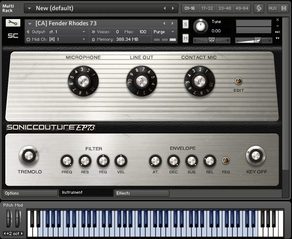
Uncontested . . . strong word; don’t you think? One would have to make sure that the claim could be substantiated or one would be considered brazen, or ill-informed, or rash, or gullible, or just plain stupid. I honestly hope that you don’t think that dear ol’ Brother Charles fits into any of those categories. *Smile.
SonicCouture have not simply raised the bar; they may even have ‘become’ the bar, as regards Rhodes MKI sample libraries. Man, this library rockZ. I mean it . . . this library abso-freakin-lutely RockZ! The depth and detail of SonicCouture’s sampling process is immense.
The level of realism is tremendous. The release noises, the pedal noises, the triple-layered Round Robin sampling, the attention to sonic detail, the inclusion of close and contact mic’d acoustic/mechanical sounds all contribute to making this perhaps THE MOST unique and authentic-sounding virtual Rhodes to date.
SonicCouture occasionally offer sales, but the Listed Retail Price of $129 is very fair in ratio to the sound quality. I have to be careful that I don’t brag this sample library up too much; we don’t want them raising the price . . . *Grin.
Not many would argue against the statement that Native Instruments’ “Kontakt” has become the industry-standard sample engine. There are other samplers, but feature-for-feature, Kontakt is the champion. Many vintage keyboard sample-sets and libraries have been produced for the Kontakt platform. The “Scarbee Vintage Keys Collection” is strong and very authentic-sounding. For that matter, the classic keyboards which are bundled with the 27GB Native Instruments “Factory Library” are also excellent performers. One of my own personal all-time favourites is PrecisionSound’s “Dusty Electric MKII”, a terrific Rhodes Mark II sample-set.
However . . . At present we are dissecting one Kontakt-powered sample library with inherent sound quality that is truly capable of making a player’s jaw drop; SonicCouture’s “EP73 Deconstructed”. This deeply-sampled, 24 bit library is comprised of 15GB of exceptionally well-recorded samples (Don’t worry, NCW compression has it shrunk down to just under eight GB). It is little wonder that the library is so large; it contains 14 velocity layers of 24 bit sampling. It is interesting to note that most professional pianists don’t require more than eight or nine velocity layers to reproduce realistic and expressive performances. There are also *three layers of Round Robin available for each of the sound parts. These sound parts are made up of the primary “Line Out”, the “Close Mic” acoustic sounds, and the mechanical sounds recorded via a ‘contact’ microphone. Needless to say, the level of realism and playability is practically unparalleled.
The published keyboards review I wrote preceding this one, was my exhaustive look into the fan-tab-u-lous “EZkeys Essential Pianos” collection from ToonTrack. The ToonTrack suite contains one of the best-sounding, fastest-loading MKI sample libraries out there. The ToonTrack Rhodes sounds incredible; especially considering its small footprint of only 500 MB. On the opposite point of the pendulum is this full-fledged sample library from SonicCouture. It is not for the feint of heart or those trying to get as many instruments as possible loaded into a netbook. Nope . . . this is a sample library for those who have the system capacity and a desire for absolute perfection; regardless of data size.
What’s more, “EP73 Deconstructed” isn’t only one of the very BEST Rhodes Mark I sample library available, SonicCouture have gone down the rabbit hole and constructed sublime creative effects and some kool, krazy, weirdness. There are five variations, or as SonicCouture say, five ‘instruments’, included in this sample library. These are: EP73 Keyboard, EP73 Bowed, EP73 Mallets, EP73 Plucked and EP73 SFX. I think of SonicCouture’s “EP73” as a prime example of coaptation. “Wow, fancy word, Bro. Charles; but, what does it mean?”
Installation and Authorization:
Don’t own the full $399 Kontakt software? No worries, this sample library is activated via Native Instruments’ Service Center and is licensed to be used within the FREE Kontakt Player. The sample library is equally usable and feature-rich in either case. ** NOTE: This library requires Kontakt 5.01 or newer. Visuals:
\koh-ap-TEY-shuhn\, noun: a joining or adjustment of parts to one another.
SonicCouture have creatively divided the sonic elements of a Rhodes electric piano into separate elements, and subsequently reformed them together into a unified, sound-creation package. Coaptation in action, as it were. Obviously, the EP73 Keyboard is the marvellous, King of the collection. Nevertheless, the remaining four instruments provide unique, creative instruments that are sure to tickle the fancy of the more musically adventurous among us. 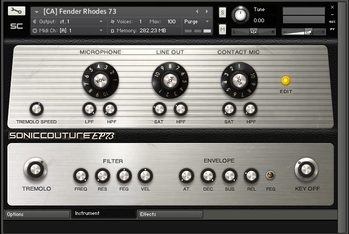
I believe that this is one of the coolest Kontakt-powered GUIs I have ever seen. This one has vintage cool smeared all over it. There are one or two other Rhodes sample libraries that also sound and look really good, but this interface has serious 1973 charm unlike any other. Subtleties and attention-to-detail are well observed here.
Three configuration tabs are placed along the bottom of the interface to allow effects selection and instrument adjustments – these are Options, Instrument and Effects.
[Instrument Tab] The first thing to grab your attention is the retro, Fender-style knobs. These sit sexily atop the silver, anodized, ridged grill, mimicking exactly what you would see while facing the original instrument. The lower panel has the appearance of smooth, anodized metal plating with ribbed, smaller buttons for controlling filter and envelope parameters. Advanced instrument features are cleverly disguised as vintage, true-to-form, amber indicator-lights. When clicked on, they light up brightly revealing knobs used to manipulate tremolo speed, saturation, low pass filtering, and etcetera. This is all wrapped up tightly with too kewl-looking faux tolex. [Options Tab] The Options Tab features a velocity control area where a player can set both the minimum and maximum velocity values, velocity sensitivity, as well as the velocity curve itself. The lower portion of this tab houses controls for adjusting noise sample levels, pedal noise, resonance and Round Robin features. To make more efficient use of available system RAM, 3x Round Robin layers can be disabled. This is *NOT a bad thing, considering there are 14 velocity layers anyway. If you are using the EP73 as a primary-focus instrument, then yes, the triple-layered Round Robin feature yields tremendous realism. The counter-balance of keeping all Round Robin layers engaged demands a lot of memory and extra CPU cycles. Disabling the Round Robin samples on the “Microphone” and “Contact Mic” samples is especially advisable. This will free up a good amount of memory and is undetectable in a typical mix. 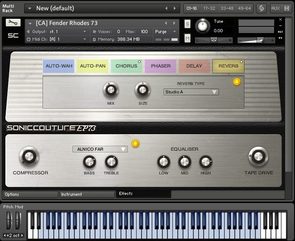
[Effects Tab]
The Effects Tab contains the pleasant-looking, easy-to-navigate effects control center. Here, we are provided Auto Wah, Auto Pan, Chorus, Phaser, Delay and Reverb. Kontakt’s built-in DSP effects are some of the very best available and SonicCouture have created a lovely interface by which to manipulate them. The colors seen here are a pleasant departure from most GUIs, in that they are softer, pastel shades.
The lower panel grants access to a simple, one-knob compressor, speaker cabinet selection menu, and a functional three-band EQ. The EQ section is actually a front-panel to Native Instruments’ “Solid Mix Gold EQ”. “Rounding” off this processing group is the “Tape drive” emulation. (*Grin . . . rounding off . . . get it?) This is one of the features now included in Kontakt 5.x. It’s a decent ‘quick n dirty’ tape emulation that lets you dial up some nifty soft saturation all the way through obvious grunge. It does however, round off the high frequencies somewhat.
Operations & Control:
[Presets & Patches] SonicCouture have neatly shrink-wrapped a heaping bevy of Kontakt patches for us in this sample library. Admittedly, the factory presets are nicely configured, providing GREAT, highly usable sounds right out of the box. The assortment of presets include “suitcase-like” sounding patches, variations of classic phase, funky “lid-less” sounds, crunchy tones, and rich, ambient stage textures. There is even a unique “No amp” patch that eliminates the Line Out mix, rendering only the acoustic, mechanical sounds of the Rhodes. Technically, the EP73 library contains five individual instruments. Each of these is accessible individually by loading up the appropriate base patch. Subdivided into two nested folders are dozens of neatly categorized presets. One folder is dedicated to special effects and creative offerings; the other is specific to more typical Rhodes settings (well, typical by SonicCouture’s standards, that is *Grin). The sound-creation patches are certainly an interesting lot. The user is amply supplied with alluring harp-like sounds, unusual sound effects, bowed tines, and luxurious, mallet plucks n’ strikes. The latter could even be creatively used in lieu of steel drums, marimba or xylophone. This collection of unique ‘Rhodes-ness’ is bounteously coated with cinematic, sonic frosting. The cinematic patches are a fine fairing of some of the most unique and evocative that you are likely to ever hear produced by any classic electric piano library. A wonderful aspect of it all is that as unusual as these instrument patches are, the definitive, princely charm of a vintage Rhodes is inescapable. The overhead and/or contact mic samples are not active while some of the instrument patches are loaded. Unfortunately, the mic samples still get stored into memory even though they aren’t being accessed. This can be a bit of an issue for anyone working in a 32 bit environment due to the substantial memory requirements. Though it is mildly inconvenient, I recommend double-checking the factory presets to determine whether they are using any of the extra samples. If the mic and/or contact mic samples are not being used, simply unload them and save the preset with a new name. This can decrease memory consumption by close to half in some cases.
Sound Quality:
In a word, stunning. At the risk of redundancy, I’m obliged to reiterate my initial findings. The bombastic degree of authenticity is next to overwhelming. I’ve read a few comments regarding this sample library that were not as favourable as my own – so . . . go listen again, naysayers. *Big, comical Grin. This delicious heap of “Kontakt-ed-ness” ‘is totally Da bomb; know wut Ah’m sayin’? The complete span of typical Rhodes sounds are here, and then some. This EP can be as silky smooth as Mae West’s stockings, or it can be a dynamic, gritty rocker with sassy, saturated attitude. It is my sincere opinion that EP73 Deconstructed reaches under the tines, and brings out “the real deal” just a little better than most. I do not make that statement lightly. I hold Scarbee’s “Mark I” (Vintage Keys Collection) in very high regard. I’m absolutely sold on ToonTrack’s “Classic Electrics – Electric MK I”. Although it’s small and stays in the welter weight division, PrecisionSound’s “Dusty Electrik Mark II” takes its fair share of trophies home. Notwithstanding, when a company takes months to carefully deep-sample a superbly reconditioned Rhodes 73, and combines it with a handsome interface, and mixes in the choicest FX, and polishes it with hand-crafted Round Robin layers, and tops it off with elaborate Kontakt scripting, the resultant VI can’t help but be pure platinum quality. I appreciate the fact that SonicCouture haven’t ‘cleaned up’ the character and imperfections of the original instrument. Instead, they brought the quirks forward and gave this sample library a level of realism that’s practically unprecedented. This astounding degree of quality does come at a price – the install base is quite large, finally settling in at just under eight gigabytes. So you ask, “How well does it sit in a mix?” I’m glad you asked. Not only does EP73 ‘own the stage’ while played as a stand-alone instrument, it can behave itself very nicely in a mix. There’s no need to rely on external, 3rd party plug-ins either. The onboard EQ is perfectly capable of producing excellent mix-friendly tone-shaping, thanks to Native Instruments’ built-in Solid Mix Gold EQ (Kontakt 5.x). The quality of the included convolution IRs (Impulse Responses) create realistic-sounding natural-space ambience. There is even a tidy, little collection of very kool plates and springs to boot. SonicCouture has implemented a well-refined set of controls over Kontakt’s built-in tremolo capabilities. I enjoy simply playing big, full chords and being carried along by the pure Rhodes tone and lush, realistic pulse of the tremolo.
The deep-sampling of the original instrument is clearly evidenced here. As an umbrella statement, the entire octave range of this EP is a pleasure to both play and listen to. The tone is evenly-balanced. The bottom end is warm, rich and full. Delectable mallets and tinkling tines endear themselves with smooth, satiny lustre, but can also be glassed up nicely to really “pop” in the upper register.
You may already know what “Round Robin” means, but just in case it isn’t yet clear to some of you, let me quickly explain it. Round Robin sampling is a method used to improve virtual instrument realism by “rotating” alternate same-note samples. This prevents tonal predictability and the dreaded “machine gun” effect.
The average recording project will most likely not require the overflowing level of realism that this sample library provides. Unless a producer is planning on making the Rhodes a predominant instrument in the mix, there may not be any need to keep the additional Round Robin layers enabled. Trust me you, the true-to-form sound quality of the 14 velocity layers remain head and shoulders above most nearly any other contending Rhodes sample library. As regards the plucks, harp-like samples, sound-creation, bowed tines, and unique cinematic sounds available, I’m not quite sure how to compare them. I suppose I could safely compare their quality to those in libraries such as Native Instruments’ “The Giant”. Within the “Sound Design” presets folder, there resides a heaping pallet of unusual and engaging cinematic instrument-patches. The collection is headed by a dizzying range of “bowed tines” presets. Many of these sounds are quite spectacular and lend themselves to sci-fi, mystery, or fantasy sound tracks with consonant ease. The quality of ambience effects and pre-configured filter assignments are immersive and captivating. Complete Glissando control is provided via the “Options” panel. Me thinks that this particular subset of EP73 will be the most unique and uncommon sounds you will have ever heard emitted from a classic electric piano! The user will also be introduced to Nova Chord and other “synth-like” sounds. These are all made possible by incorporating and applying creative ADSR filtering to the normal keyboard samples. Metal struck mallet sounds are an interesting lot. This particular variety of the bundled patches generates compelling percussive tones reminiscent of steel drums or xylophone. The “Plucked” samples offer a most nearly harp-like quality. Perhaps one could describe these samples as sounding somewhat like rock n’ roll harps. The listener can still hear plenty of Rhodes tone, but “plucking” the EP’s strings with a guitar pick definitely produces harp-like sounds. However, one very interesting preset grouped with the “Plucked” category is the “Twisted Glass” patch. This one does indeed have a large, dense, glass-like vibe about it. Whoa, man! What is that? Many of the EFX patches are just plain weird. Weird in a krazy, kool way. The effective application of filtering and enveloping make these patches the perfect choice for fantastic and imaginative sound effects. Be sure to check out the video links – you’ll “see” what I mean.
CPU Consumption:
As with any high quality, modern, Kontakt sample library, this one can be moderately imposing. A relatively up-to-date 64 bit dual or quad core system should be able to handle this library with relatively few hiccups. Limiting the Round Robin layers and/or “unloading” unneeded samples allow this fine sample library to be much more amiable towards resource-limited systems. This library performs “ok” on my six year old, dual core, AMD test system. It operates very well on my newer INTEL i3 system. Concluding Remarks: I commend SonicCouture for their dedication, painstaking efforts and unsurpassed attention to detail. Each of the SC sample libraries I have been exposed to have obliged me to count them among the very finest available. The cinematic and sound-creation instrument-patches included with this library do not come up short either. Contained in this eclectic collection are presets that will wow your listeners with offbeat, unique “cinema-goodness”. If your system has the hard drive room to spare, and you are looking for one of the most realistic, deeply-sampled Rhodes libraries ever produced, you owe it to yourself to outfit your arsenal with this one. You will not be disappointed! You have Brother Charles’ word on that!
Brother Charles is a freelance writer, Gospel music artist and minister. Charles had been a professional touring musician during the nineties; working primarily as a lead guitarist in the Canadian country music industry. Brother Charles is also involved with music production and quality home recording.
1 Comment
Guy Smiley
6/22/2022 02:50:30 pm
Very cool review! Thanks for going into lots of detail and ferreting out the nitty gritty bits. Please keep making videos too.
Reply
Your comment will be posted after it is approved.
Leave a Reply. |
NO SPAM! IK Multimedia Group Buy
FX Pick & Mix Group Buy - up to 16 for the price of 1
Will You Help?Web hosting is getting more and more expensive all the time, and Reviewer's Revival is NOT funded nor supported by any commercial enterprise or business. A donation of any amount is greatly appreciated. Even $2 or $3 for a coffee - every little bit helps. Thanks very much.
Legal BlurbAll of the articles published on Reviewer's Revival are undertaken to be purely objective, impartial reviews. Reviewer's Revival is not owned, funded-by, nor hired by any company or individual. Reviewer's Revival is the sole property of, and solely under the discretion and direction of Brother Charles. |

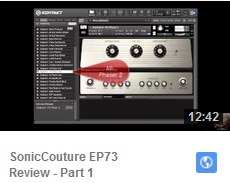
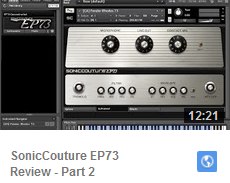




 15% OFF Summer Sale!
15% OFF Summer Sale!
 RSS Feed
RSS Feed

